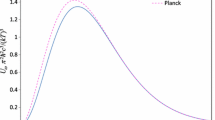Abstract
Einstein and Ehrenfest's radiation theory is modified in order to take into account the effects of the random zero-point fields, characteristic of classical stochastic electrodynamics, in a system of classical molecules interacting with thermal radiation. This is done by replacing the Einstein concept of “random spontaneous emission” by the concept of stimulated emission by the random zero-point fields. As a result, Compton and Debye's kinematic relations are obtained within the realm of a completely classical theory, that is, without having to consider the wave-particle duality for the molecules or the radiation.
Similar content being viewed by others
References
A. Einstein,Ann. Phys. (Leipzig) 17, 132 (1905).
R. Kidd, J. Ardini, and A. Anton,Am. J. Phys. 57, 27 (1989).
A. Einstein,Phys. Z. 18, 121 (1917).
H. R. Lewis,Am. J. Phys. 41, 38 (1973).
A. Einstein and P. Ehrenfest,Phys. Z. 19, 301 (1923).
R. Stuewer,The Compton Effect, Turning Point in Physics (Science History Publications, New York, 1975), p. 234.
T. H. Boyer,Phys. Rev. D 11, 790, 809 (1975).
P. Claverie and S. Diner,Intern. J. Quantum Chem. 12, Suppl. 1, 41 (1977).
L. de la Peña, inStochastic Processes Applied to Physics and Other Related Fields, B. Gomez, S. M. Moore, A. M. Rodriguez-Vargas, and A. Rueda, eds. (World Scientific, Singapore, 1982), pp. 428–581.
M. Surdin, inOld and New Questions in Physics, Cosmology, Philosophy and Theoretical Biology, A. van der Merwe, ed. (Plenum, New York, 1983), pp. 469–493.
P. W. Milonni,Phys. Rep. 25, 1 (1976).
P. A. M. Dirac,Proc. R. Soc. (London) A 114, 243 (1927).
J. D. Jackson,Classical Electrodynamics (Wiley, New York, 1974), Chap. 17.
T. A. Welton,Phys. Rev. 74, 1157 (1948).
H. M. França and T. W. Marhall,Phys. Rev. A 38, 3258 (1988). See also C. Cohen-Tannoudji,Physica Scripta T 12, 19 (1986).
D. Park and H. T. Epstein,Am. J. Phys. 17, 301 (1949).
T. H. Boyer,Phys. Rev. A 29, 2389 (1984); A. V. Barranco, S. A. Brunini, and H. M. França,Phys. Rev. A 39, 5492 (1989).
R. Blanco, H. M. França, and E. Santos,Phys. Rev. A 42, 693 (1991).
T. W. Marshall,Proc. Cambridge Philos. Soc. 61, 537 (1965).
T. H. Boyer,Phys. Rev. 182, 1374 (1969);Phys. Rev. 186, 1304 (1969).
A. V. Barranco and H. M. França,Phys. Essays 3, 53 (1990).
P. W. Milonni and M. L. Shih,Am. J. Phys. 59, 684 (1991).
J. L. Jimenez, L. de la Peña, and T. Brody,Am. J. Phys. 48, 840 (1980).
A. Einstein and L. Hopf,Ann. Phys. 35, 1105 (1910). See also P. W. Milonni,Am. J. Phys. 49, 177 (1980).
A. H. Compton,Phys. Rev. 21, 483 (1923).
P. Debye,Phys. Z. 24, 161 (1923).
O. Richardson,Phil. Mag. 27, 476 (1914).
See also Ref. 6, p. 60.
G. Wentzel,Z. Phys. 41, 828 (1927).
E. Schrödinger,Ann. Phys. 82, 257 (1927).
O. Klein and Y. Nishina,Z. Phys. 52, 853 (1929).
I. Tamm,Z. Phys. 62, 545 (1930).
M. O. Scully and M. Sargent III,Physics Today, March 1972, pp. 38-47.
K. Hagenbush,Am. J. Phys. 45, 693 (1977).
J. N. Dodd,Eur. J. Phys. 4, 205 (1983).
R. Kidd, J. Ardini, and A. Anton,Am. J. Phys. 53, 641 (1985).
J. Strnad,Eur. J. Phys. 7, 217 (1986).
Y. H. Woo,Phys. Rev. 25, 444 (1925).
T. W. Marshall and E. Santos,Found. Phys. 18, 185 (1988).
T. W. Marshall and E. Santos,Phys. Rev. A 39, 6271 (1989);Am. J. Phys. 58, 683 (1990).
A. Pais,Rev. Mod. Phys. 51, 863 (1979). See alsoSubtle is the Lord... (Clarendon Press, Oxford, 1982), p. 468.
A. Einstein letter to M. Besso, inAlbert Einstein, Correspondence avec Michele Besso 1903–1955, P. Speziali, ed. (Hermann, Paris, 1972), pp. 509–516.
Author information
Authors and Affiliations
Rights and permissions
About this article
Cite this article
Barranco, A.V., França, H.M. Einstein-Ehrenfest's radiation theory and Compton-Debye's kinematics. Found Phys Lett 5, 25–42 (1992). https://doi.org/10.1007/BF00689794
Received:
Revised:
Issue Date:
DOI: https://doi.org/10.1007/BF00689794




